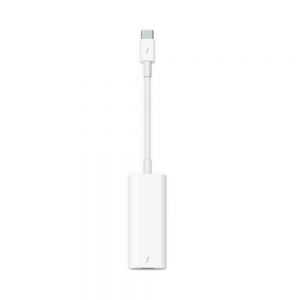The new MacBook Pros announced October 27 2016 have taken the plunge that we guessed was coming: All USB Type C ports, all the time. (for a refresher on Type C, see our article here)
Following on after the opening salvo of the 2015 MacBook Retina, Apple has jettisoned all other digital ports in favour of the small USB Type-C 3.1 port for power, video, storage, networking and peripherals. The first and most obvious effect is that your USB printers, mice, USB memory sticks, scanners and external hard drives have nowhere to plug in, and neither do your cabled network connection and expensive new Thunderbolt drives. That’s more than a little inconvenient.
Fortunately there are some adapters on the market to make things connectible. Cable adapters are available for USB C to:
- USB 3.0 A Female (this is the one for using your existing peripherals with)
- USB 3.0 A Male (this will be little used but can be used for charging. Reportedly, this can be used in Target Disk Mode between two Macs)
- HDMI video (in both 1080p and 4K versions)
- VGA video (carry this if you have to hook up to other peoples projectors for meetings and presentations
- DVI Video and DVI video plus USB C charging port
- RJ-45 Gigabit Ethernet (for wired networks when WiFi won’t do)
- USB 3.o Micro B and USB 2.0 Micro B and USB 2.0 Mini B (for phones, tablets, cameras, etc., choose the right one(s) for your devices)
- Lightning (for iPhones and iPads)
- USB C to USB C for charging and for connecting USB C peripherals.
There are also combination adapters that give multiple USB 3.0 Female ports, and/or video and network outputs. One key thing to look for in a combo adapter is the presence of a USB C Female port for charging power. If you have a combo adapter with video & or network out, plus an extra charger and a C to C cable, then you have a functional desktop dock that you can leave at your desk and plug into your laptop with just one connection when you sit down. Combo adapters are available in
- 4 x USB 3.0 A Female plus USB C charging port
- 1 x USB 3.o A Female,1 x Gigabit Ethernet, 1 x HDMI video plus USB C charging port
- 3 x USB 3.0 A Female 1 x Gigabit Ethernet plus USB C charging port
Link to CanadaRAM’s USB 3.1/Type C cables, adapters and hubs page
OWC has a full blown USB C docking station with 4 x USB 3.1 A Female (Gen 1) . HDMI, Gigabit Ethernet, 3.5mm audio out, SD card reader, 2 x USB C 3.1 Female and has its own 80W power input to charge the MacBook Pro and power the USB A ports.
But what about Thunderbolt?
The new Thunderbolt 3 specification uses the USB Type C, connector, so Thunderbolt is included in the USB C ports of the new Macs, which means you can potentially have four Thunderbolt drive daisy-chains (but read more later*). As of this writing, the only game in town for Thunderbolt 1 and 2 devices is the Apple Thunderbolt 3 to Thunderbolt 2 adapter.
So if you are keeping track, there was the DisplayPort video interface, which Apple implemented using the Mini DisplayPort connector, then Thunderbolt was introduced using the same connector as MiniDisplay port, so you had storage+video. Now the USB bus + Thunderbolt storage + DisplayPort video protocol are all embedded in the new USB C / Thunderbolt 3 port.
Those of us still using Firewire drives, video cameras and audio interfaces may be at the end of the road, as it is yet to be seen if the triple shuffle of Apple Thunderbolt 3 to Thunderbolt 2 adapter then an Apple Thunderbolt to Firewire adapter will work.
* For more details, the USB C ports on the Late 2016 machines do implement the full Gen 2 10 Gbps bandwidth USB 3.1 protocol, as opposed to the MacBook Retina (which ran Gen 1 at half the potential speed), and all ports on the new MacBook Pros support Thunderbolt 3. However the MacBook Pro 13 inch models with the TouchBar do not implement the full Thunderbolt 3 throughput on 2 of the 4 ports, the ones on the right hand side have reduced PCI-e performance. The USB C port on the 2015 Retina MacBook does not support Thunderbolt.
Apple has done this before, abandoning 3.5in floppy drives long before the rest of the industry, dropping Firewire from their Pro models for Thunderbolt, dropping optical drives and abandoning SATA internal drive connections and hard drives in the MacBook Pro and Mac Pro models entirely for frustratingly proprietary SSD interfaces.



